Coronavirus (COVID-19): state of the epidemic - 14 April 2022
This report brings together the different sources of evidence and data about the Covid epidemic to summarise the current situation, why we are at that place, and what is likely to happen next.
This document is part of a collection
Estimated Infection Levels and Case Numbers
Estimated Infection Levels
The reproduction number (R) is the average number of secondary infections produced by a single infected person. If R is greater than one the epidemic is growing, if R is less than one the epidemic is shrinking. The higher R is above one, the more people one infectious person might further infect and so the faster the epidemic grows. Please note that R is an indicator that lags by two or three weeks. For more information please visit the UK government website.
The UK Health Security Agency's (UKHSA) consensus estimate for R in Scotland as at 29 March is between 0.8 and 1.0. The lower and upper limits of the R value have both decreased since the last published figure (Figure 1)[3] [4].
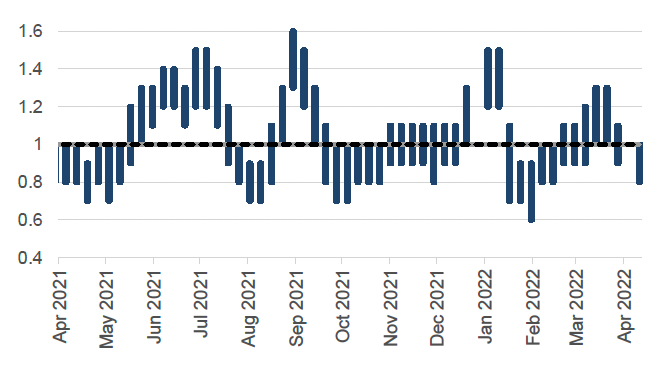
As at 29 March 2022, the UKHSA's consensus view was that the incidence of new daily infections in Scotland was between 348 and 1,032 per 100,000 people. This equates to between 19,000 and 56,400 people becoming infected each day in Scotland[6][7].
The growth rate reflects how quickly the numbers of infections are changing day by day. It is an approximation of the percentage change in the number of new infections each day. More information can be found on the UK government website.
The latest growth rate for Scotland as at 29 March was between -4% and 0%. The upper and lower growth limits have both decreased since the last published figure[8] [9].
Wastewater Estimates
The Scottish Government has been working with the Scottish Environment Protection Agency (SEPA) to detect and analyse fragments of Covid-19 virus RNA in wastewater. The number of locations where the levels of SARS-CoV-2 in wastewater are monitored has increased to 141 sites around Scotland. In contrast to Covid-19 case records, virus shedding into wastewater is a biological process. This means that wastewater data is unaffected by factors that impact whether testing is done.
Overall, there has been a decline in nationwide wastewater SARS-CoV-2 RNA over the last two weeks. The week ending on 12 April saw levels of around 240 million gene copies per person per day (Mgc/p/d), a decrease from 296 Mgc/p/d two weeks ago (week ending 29 March). However, there has been a slight rise in SARS-CoV-2 RNA levels in the last week of data available (Figure 2)[10].
While there are decreases in wastewater Covid-19 levels across most of Scotland, eight local authorities have increased their levels over the past week. Increases were reported in Angus, Clackmannanshire, Dumfries and Galloway, Fife, Moray, North Ayrshire, North Lanarkshire and South Lanarkshire. Please note that comparisons for Na h-Eileanan Siar, Orkney Islands and Shetland Islands are not possible due to sampling coverage.
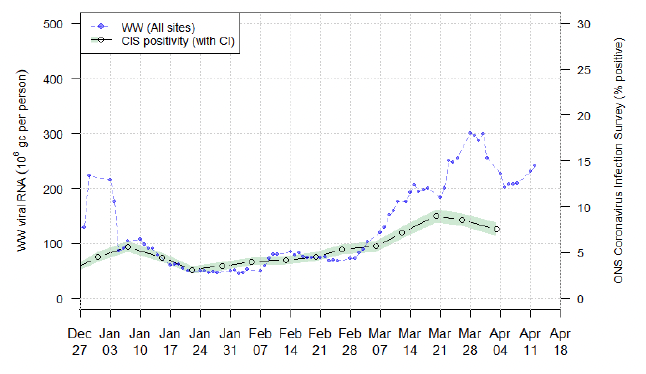
Covid Infection Survey
The Covid-19 Infection Survey is a UK wide study carried out by the Office for National Statistics (ONS) and the University of Oxford. The survey invites private residential households to test whether they have the infection, regardless of whether they have symptoms, using a PCR test. This means the study is unaffected by testing policy changes in early 2022. Participants are also asked to provide a blood sample to test for antibodies.
In Scotland, the percentage of people testing positive for Covid-19 as estimated by the Covid-19 Infection Survey continued to decrease in the most recent week (3 to 9 April), as seen in Figure 3[14]. This follows a period of increasing Covid-19 prevalence from mid-January to mid-March 2022, the estimate for the week 14 to 20 March 2022 was the highest estimate for Scotland since the survey began. The estimated percentage of people testing positive for Covid-19 in the private residential population in the week 3 to 9 April in Scotland is 5.98% (95% credible interval: 5.35% to 6.62%)[15], equating to around 1 in 17 people (95% credible interval: 1 in 19 to 1 in 15).
In the week 3 to 9 April 2022, estimates for the other nations of the UK are as follows and can be seen in Figure 3:
- In England, the percentage of people testing positive decreased: 6.92% (95% credible interval: 6.72% to 7.13%), equating to around 1 in 14 people (95% credible interval: 1 in 15 to 1 in 14).
- In Wales, the percentage of people testing positive remained high: 7.63% (95% credible interval: 6.79% to 8.55%), equating to around 1 in 13 people (95% credible interval: 1 in 15 to 1 in 12).
- In Northern Ireland, the percentage of people testing positive decreased: 5.23% (95% credible interval: 4.30% to 6.21%), equating to around 1 in 19 people (95% credible interval: 1 in 25 to 1 in 16).
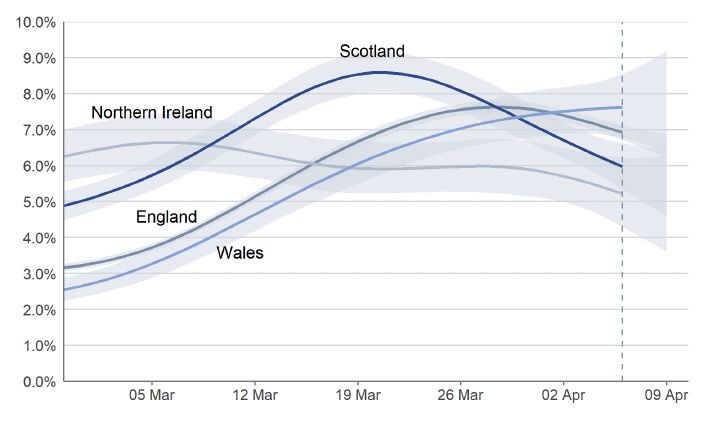
In Scotland, the estimated percentage of people testing positive decreased across all ages in recent weeks[16]. Meanwhile, the case rates (including reinfections) by specimen date also show a decrease in all age groups in the week to 9 April compared to the previous week, in line with the overall decreasing trend[17].
Omicron BA.2
The Omicron variant was first detected in Scotland on 29 November 2021[18]. It had a growth advantage over the previously dominant Delta variant, but a lower clinical severity. The parent variant (Pango lineage B.1.1.529) can now be separated into five main groups: BA.1, BA.2, BA.3, and recently classified BA.4 and BA.5[19]. In the period between 10 January and 30 March 2022 only one sequence of BA.4 has been identified in Scotland. As of 25 March 2022 there was no reports of the BA.5 in Scotland[20]. The BA.1 lineage of Omicron was originally dominant within Scotland, however, the first specimen date reported for BA.2 was 23 December 2021; BA.2 is now the dominant variant in Scotland and its incidence is increasing[21]. The latest BA.2 risk assessment update issued on 23 March indicates that BA.2 has a growth advantage compared to BA.1; however, the clinical severity of BA.2 is similar to that of BA.1[22]. The increasing prevalence of BA.2 correlated to increasing Covid-19 prevalence in Scotland between mid-February and mid-March.
According to estimates from the Covid-19 Infection Survey, the trend in the percentage of people with Covid-19 infections compatible with Omicron BA.2 in Scotland decreased in the most recent week to 9 April, while the percentage of people with infections compatible with the Omicron BA.1 continued decrease in the most recent week (Figure 4). The Covid Infection Survey estimated that 5.31% (95% credible interval: 4.70% to 5.96%) of the private residential population would test positive with a Covid-19 infection compatible with BA.2 on 6 April[23].
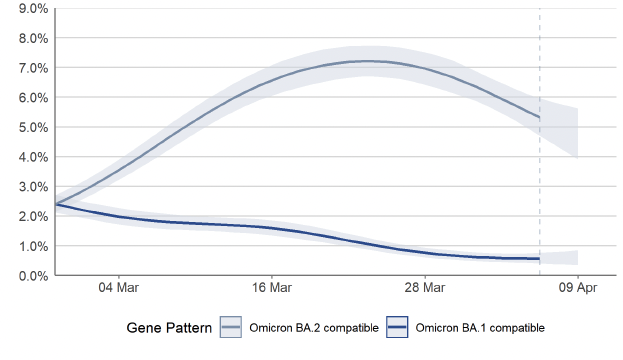
Unlike Omicron BA.1, BA.2 does not contain the deletion that leads to S Gene Target Failure in a widely used PCR testing platform available at UKGov Pillar 2 Lighthouse Laboratories. This is used as a reasonable proxy to track BA.2 as opposed to BA.1. UKGov laboratories process the majority of PCR tests in Scotland. Of the new cases in Scotland that were notified on 11 April from UK Government laboratories, 97.9% were S gene positive. This is similar to 97.7% of cases 7 days previously[25].
Details of risk assessments for both BA.1 and BA.2 carried out by UKHSA can be found on the UK government's website[26] and in the State of the Epidemic reports published on 4 February and 28 January 2022. For more information on vaccine effectiveness and Omicron BA.2, please see the Vaccine Effectiveness Against Omicron.
Recently UKHSA has announced changes to their variant classification system which will take effect from 1 April 2022[27]. In the new system, a Variant of Concern (VOC) category will be assigned to emerging or circulating variants which show a detrimental change in biological properties such as transmissibility, severity or immune evasion and growth rate potentially compatible with maintaining transmission and/or displacing the current dominant variant. New variants will receive a variant number (V-date-number) and will undergo routine assessment when sufficient number of cases will accrue. There will be no other variant categories, including no Variant Under Investigation (VUI) category. Previous variants of concern which no longer meet the criteria above will be redesignated.
Covid-19 Cases
Please note that from 5 January, the Covid-19 case definition includes cases confirmed by either a PCR or LFD test, or both. Comparisons over time need to be made with caution. For more information on the difference between reporting and specimen date, please see this earlier publication. Cases data by specimen and reporting date include reinfections (where a person has a positive test 90 days or more since their last positive test).
By specimen date, the seven-day combined PCR and LFD case rate (including reinfections) decreased in Scotland in the week leading up to 9 April. This follows a period of sharply increasing case rates from late February to mid-March. There were 728 weekly combined PCR and LFD cases per 100,000 population in the week to 9 April, which is a 25% decrease from 973 weekly cases per 100,000 on 2 April. This remains a very high case rate compared to previous phases of the pandemic in Scotland (Figure 5)[28].
However, comparisons with data from before 5 January 2022 must be made with caution as differences are likely to reflect changes in testing behaviour and policy rather than changing infection levels alone.
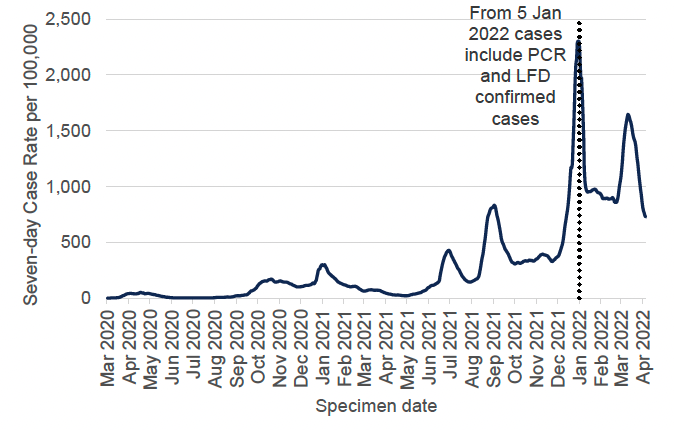
The week leading up to 9 April saw decreasing case rates in all age groups compared to the week ending 2 April. In the most recent week, the decrease ranged from 13% for those aged 70 to 79, to 41% for those aged 19 or younger (Figure 6)[30]. This is consistent with CIS estimates, which indicate the estimated percentage of people testing positive decreased across all ages in recent weeks in Scotland[31].
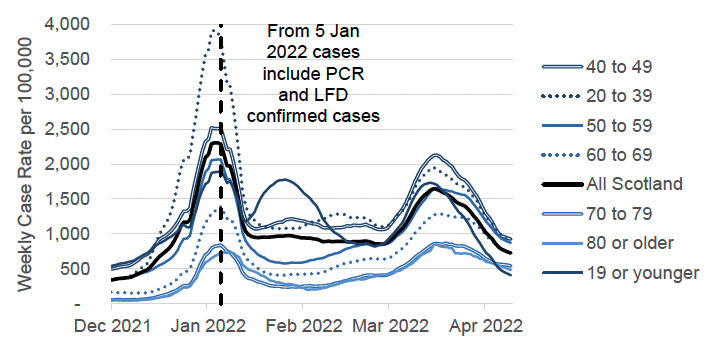
Rising numbers of weekly Covid-19 cases among care home residents throughout February and March were in line with the increasing case numbers among older age groups in the same period, and the number of Covid-19 cases among care home residents peaked in the week to 11 March, with 937 reported cases. Case numbers have since decreased, and in the week to 8 April there were 393 reported cases among care home residents, which is a decrease of 18% from the previous week ending 1 April (482 cases)[34].
In line with recent changes to testing policy in England and upcoming transitions to long term strategies in other nations across the UK, cases comparison between countries will no longer be included in the report. For more information see following links for England, Scotland, Wales, and Northern Ireland.
To compare trends in estimated infection levels in private residential households across the UK, please see the previous section on the Covid Infection Survey.
Reinfections
A reinfection is defined as a positive test 90 days or more after a previous positive test. This amount of time is set in order to be able to distinguish between viral persistence of the primary Covid-19 episode and a true reinfection.
The increase in the proportion of reinfections seen in late 2021 corresponds to the emergence of the Omicron BA.1 variant in the UK. The proportion of reinfections in Scotland when Omicron BA.1 was first detected on 29 November[35] was 0.8% percent of total cases. These are cases in individuals for whom it has been 90 or more days since their last positive Covid-19 test.
The proportion of reinfections among the total weekly cases has increased in the most recent week. By specimen date, there was a total number of 4,268 reinfection cases confirmed by either a PCR or LFD test in the week leading up to 9 April. This represent 10.7% of all reported cases, which is a slight increase from 10.6% in the week leading up to 2 April. This is the highest level of reinfections seen in the pandemic (Figure 7)[36].
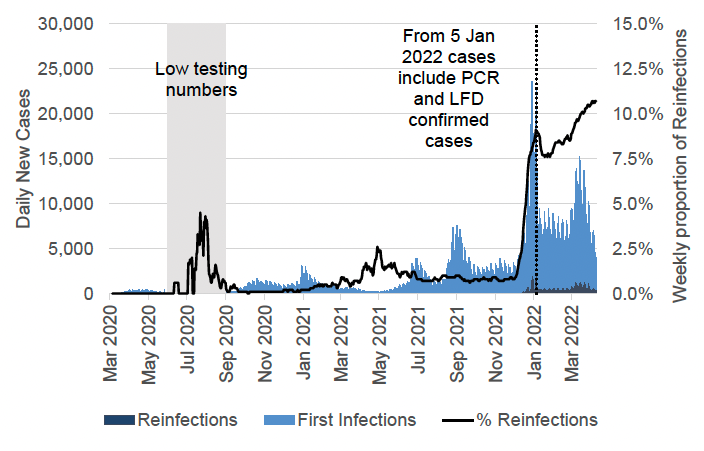
LFD Testing
The weekly total of tests reported in the week to 10 April decreased by 23% from the previous week leading up to 3 April. There were 340,124 reported tests in the week to 10 April (Figure 8)[38]. Please note that from 18 April LFD Universal Offer for asymptomatic testing will no longer be available.
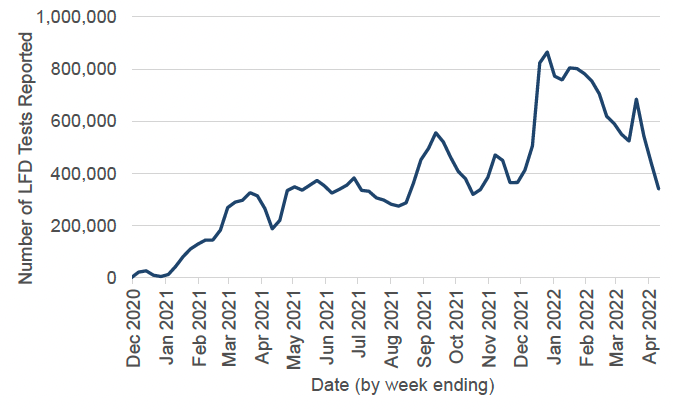
YouGov survey results have shown that on 15 to 16 March, 53% of respondents had taken a LFD/antigen test and 9% a PCR test in the past week[39]. Of those who had taken a LFD/antigen test, 44% recorded the result of their last LFD/antigen test online and 54% did not record the results online[40].
The Scottish Contact Survey asks whether people use LFD tests and if so how often. Approximately 77% of individuals had taken at least one lateral flow test within the last 7 days for the survey pertaining to the 31 March to 6 April[41].
There are differences in the results from the YouGov and the Scottish Contact Survey (SCS) which may be likely to be due to differences in sampling and methodology. YouGov is an online survey based on an active sample which is representative of the Scottish population with around 1,000 respondents[42]. The SCS[43] is based on a longitudinal survey with a larger sample of around 3,000, with the responses being modelled to represent the Scottish population.
Contact
There is a problem
Thanks for your feedback